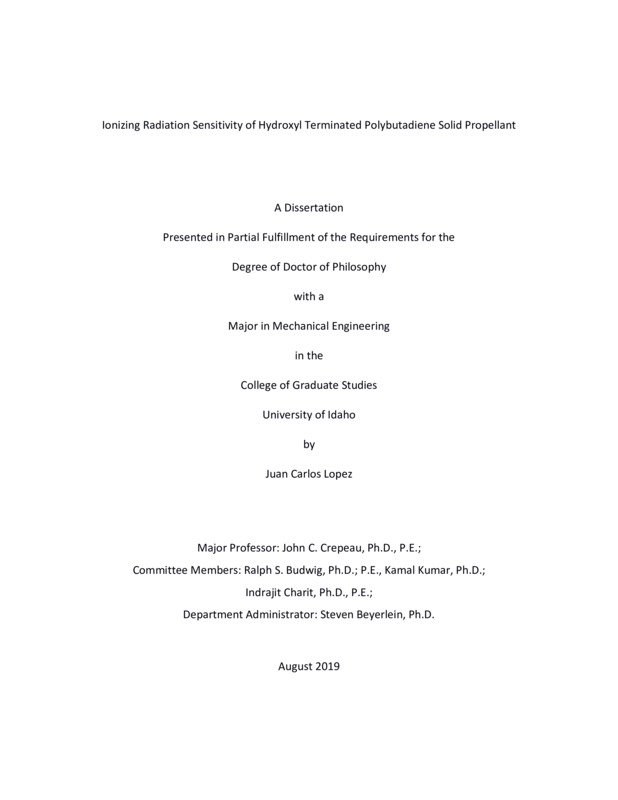Ionizing Radiation Sensitivity of Hydroxyl Terminated Polybutadiene Solid Propellant
Lopez, Juan C. (2019-08). Ionizing Radiation Sensitivity of Hydroxyl Terminated Polybutadiene Solid Propellant. Theses and Dissertations Collection, University of Idaho Library Digital Collections. https://www.lib.uidaho.edu/digital/etd/items/lopez_idaho_0089e_11570.html
- Title:
- Ionizing Radiation Sensitivity of Hydroxyl Terminated Polybutadiene Solid Propellant
- Author:
- Lopez, Juan C
- ORCID:
- 0000-0002-1330-1473
- Date:
- 2019-08
- Keywords:
- Ionizing Propellant Radiation Solid
- Program:
- Mechanical Engineering
- Subject Category:
- Mechanical engineering; Aerospace engineering
- Abstract:
-
The effects of ionizing radiation on hydroxyl-terminated polybutadiene (HTPB) solid propellant are investigated to assess its sensitivity to electron radiation. Investigation into the radiation sensitivity of HTPB propellant is needed to assess potential risks to a mission aimed at landing a craft on the surface of Jupiter’s moon Europa, considering this region of space has very high particle radiation fields. This mission would require deploying a Europa Breaking Motor (EBM) using HTPB propellant to provide the necessary deceleration to safely land a craft on Europa’s icy surface. The current concept for an EBM requires motor components, including the propellant, to have a radiation sensitivity of no less than 2.4 Mrad.
While HTPB solid propellant has been studied and used in rockets to place satellites in orbit and for military applications, it has not been previously investigated to support, with sufficient confidence, missions to Jupiter’s moons. Tensile data from surrogate propellant, binder, hybrid propellant and HTPB propellant are used to derive values for radiation sensitivity on the basis of crosslink density, particle adhesion, debonding and damage to the aluminum and ammonium perchlorate. Using the Flory – Rehner and Mooney – Rivlin models, the propellant’s limiting value for crosslink density is computed with its corresponding radiation dose. The Pukansky model is used here to obtain a limiting value for the propellant bonding factor and its corresponding radiation dose. Similarly, the Nicolasis – Narkis model is use to derive values for the propellant’s particle adhesion factor and its corresponding radiation dose. Lastly, the Goodier model is applied to derive the maximum load on the aluminum and ammonium perchlorate in the propellant with their corresponding radiation dose. The computed values for radiation dose obtained from these models were then compared to the radiation sensitivity value for the EBM components of 2.4 Mrad. The results from these models show ammonium perchlorate to have a radiation sensitivity that will not support the current motor concept in relation to the 2.4 Mrad requirement. This, in turn, necessitates further refinement of the EBM design to possibly provide shielding in the case liner for the propellant.
- Description:
- doctoral, Ph.D., Mechanical Engineering -- University of Idaho - College of Graduate Studies, 2019-08
- Major Professor:
- Crepeau, John C
- Committee:
- Budwig, Ralph S; Kumar, Kamal; Charit, Indrajit; Beyerlein, Steven
- Defense Date:
- 2019-08
- Identifier:
- Lopez_idaho_0089E_11570
- Type:
- Text
- Format Original:
- Format:
- application/pdf
- Rights:
- In Copyright - Educational Use Permitted. For more information, please contact University of Idaho Library Special Collections and Archives Department at libspec@uidaho.edu.
- Standardized Rights:
- http://rightsstatements.org/vocab/InC-EDU/1.0/

